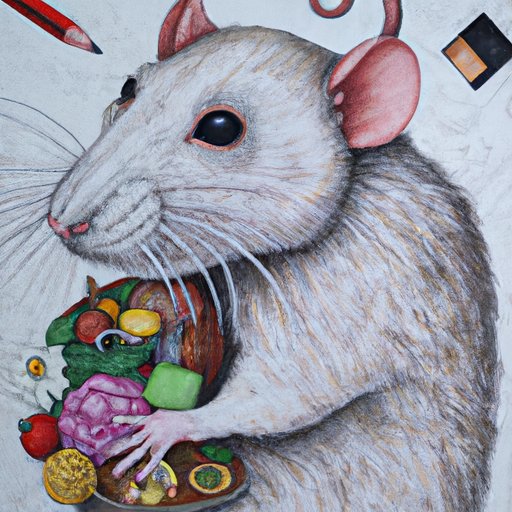
I. Introduction
Drawing animals can be a fun and challenging activity for artists of all levels. Rats, despite their bad reputation, can make for interesting and adorable subject matter in art. In this article, we will explore the process of drawing a rat, including step-by-step instructions, materials and tools, rat anatomy, species, personalities, art history, and symbolism.
Rats have had a significant place in art history, appearing in works from ancient Egyptian to contemporary art. Some famous examples include Banksy’s “Graffiti Rat” and Disney’s Remy from “Ratatouille.” Therefore, learning how to draw rats can help an artist hone their skills and offer new creative opportunities.
II. Step-by-Step Guide
Drawing a rat may seem like a daunting task, but breaking it down into manageable steps can make it more approachable. Here’s a step-by-step guide on how to draw a rat:
1. Start with the head: Draw a large circle for the head, a smaller circle for the nose, and two smaller circles for the ears. Connect the nose and ears to the head using curved lines.
2. Draw the body: Draw a long oval below the head for the body.
3. Add the legs: Draw four thin legs, each consisting of two ovals.
4. Include the tail: Draw a long, curved line for the tail, making sure it’s proportional to the body.
5. Add details: Draw the eyes, whiskers, and any additional details that will make your rat unique.
Remember to sketch lightly and create basic shapes before adding details. This will help you adjust proportions and prevent having to erase mistakes frequently.
III. Materials and Tools
Drawing a rat requires basic materials and tools. These may include paper, pencils, erasers, and coloring implements such as markers, colored pencils, or watercolors. Here are some suggestions for materials:
– Paper: Choose a paper that works for your preferences, such as sketch paper, watercolor paper, or toned paper.
– Pencils: Use a range of pencils such as 2B, 4B, and 6B to achieve different levels of shading.
– Erasers: Make sure to have both kneaded and white erasers to clean up lines and lighten areas of shading.
– Coloring Implements: Add color using markers, colored pencils, or watercolor paints.
There are many affordable options for beginners, such as art supply stores or online retailers.
IV. Rat Anatomy
Understanding rat anatomy is crucial in drawing a convincing and accurate rat. A rat’s body generally consists of the head, neck, body, limbs, and tail. Here’s a breakdown of each body part:
– Head: The rat’s forehead is flat, and the snout is pointed. The eyes and ears are large.
– Neck: The neck connects the head and body and is thin compared to the rest of the body.
– Body: The body is elongated and shaped like a cylinder.
– Limbs: The legs are thin and have pointed feet with long claws.
– Tail: The tail is thin, long, and pointed at the end.
Remember that rats come in many different species, and their anatomy can vary. Make sure to examine references and adjust your drawing accordingly.
V. Rat Species
Rats come in 51 different species, each with their unique look and personality. Some popular species in art include brown rats, black rats, and fancy rats. Here are some differences between them:
– Brown Rats: These rats are the most common, and their fur is a brown or grey color with a white belly. Their face is round, and their ears are small.
– Black Rats: These rats are slimmer and have dark, shiny fur. They have a pointed face and long ears.
– Fancy Rats: These rats are selectively bred for domestication and have a wide range of fur colors and patterns. They have rounder faces and larger, floppy ears.
When choosing a species, think about what elements of their anatomy and personality you want to emphasize in your drawing.
VI. Rat Personalities
Rats have unique personalities, and observing them in real life can help inspire your art. Rats are social and intelligent animals that exhibit curious and playful behavior. In your art, you can convey these traits through different styles and techniques, such as using bold lines, bright colors, and playful poses.
You can also explore the personalities of famous rats in art, such as Remy from “Ratatouille,” who is passionate about cooking and has a sharp mind. Remember that a rat’s personality can be conveyed in subtle ways, so don’t be afraid to experiment with your art to capture these traits.
VII. Rat in Art History
Rats have been a subject of art for centuries, appearing in works such as the “Book of the Dead” from Ancient Egypt and the drawings of Albrecht Dürer during the German Renaissance. In modern art, rats have been used for political purposes by artists such as Banksy, who incorporates rats into his political graffiti art.
In your art, you can draw inspiration from different art movements that featured rats, such as the surrealism of Salvador Dali or the comic style of Richard Scarry. You can also explore pop culture references to rats, such as the teenage mutant ninja turtles.
VIII. Rat Symbolism
Rats have been used symbolically in different cultures and contexts. In Chinese and Japanese cultures, rats are associated with prosperity and good fortune. Alternatively, rats have been associated with pestilence and disease in other cultures.
In art, you can use a rat symbolically to convey these meanings or create your unique interpretation. For example, a rat could represent a problem that needs to be solved or a symbol of resilience in the face of adversity.
IX. Conclusion
Drawing a rat can be a fun and rewarding artistic endeavor, and understanding the basics of how to draw them can help artists of all levels improve their skills. By following this step-by-step guide, considering different species and their anatomy, exploring personalities, art history, and symbolism, artists can create unique and adorable works of art.




